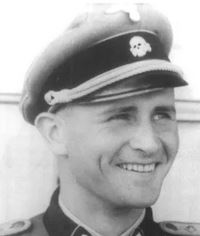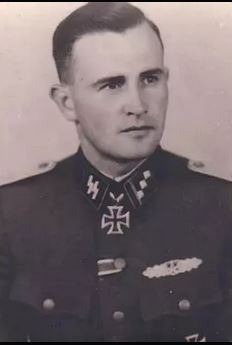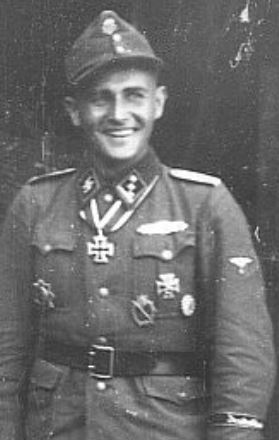Grohmann, Franz (Waffen SS)
- Date of birth:
- October 16th, 1919 (Nixdorf/Sudetenland, Czechoslovakia)
- Date of death:
- April 7th, 2000 (Erlangen/Bavaria, Germany)
- Service number:
- SS-Nr.: 423.601(V) // NSDAP-Nr.:
- Nationality:
- German (1933-1945, Third Reich)
Biography
01.11.1938: entered SS-Regiment 'Deutschland', SS-VT, München
00.03.1939: Fahrer, Kompaniechef, SS-Regiment 'Deutschland' - campaign in the Sudetes
00.09.1939: campaign in Poland with Panzer-Division 'Kempf' - Festung Modlin-Mlawa
00.05.1940-00.06.1940: campaign in the West
00.04.1941: SS-Rottenführer, SS-Regiment 'Deutschland', SS-Division 'Reich' - campaign in Yugoslavia
22.06.1941: campaign in Russia - Mittelabschnitt
23.06.1941: WIA at Jelnja - evacuated by air to Lazarett in Warsaw
00.07.1941: SS-Infanterie-Ersatz-Bataillon, Rusin, Prague
00.08.1941: Reserveoffizier-Lehrgang, SS-Junkerschule Bad Tölz
17.02.1942: SS-Oberscharführer, Zugführer, 4. Kompanie, SS-Infanterie-Regiment 'Deutschland', SS-Division 'Reich', Rshew, Moscow
22.03.1942: SS-Oberscharführer, Zugführer, Führer, Nacht-Spähtrupp
20.04.1942: promoted to SS-Untersturmführer der Reserve
00.05.1942-00.03.1943: SS-Ustuf d.R., Zugführer, 3. Kompanie, SS-Panzergrenadier-Regiment 'Deutschland', 2. SS-Panzer-Division ' Das Reich' - fightings in Oskol, East of Kharkov, East of Belgorod
22.03.1943-23.03.1943: SS-Ustuf d.R., Zugführer, 2. Kompanie, SS-Panzergrenadier-Regiment 3 'Deutschland', 2. SS-Panzer-Division ' Das Reich', WIA when stopped a Soviet armored attack and destroyed 5 tanks and dammaged 3 tanks
21.06.1943: promoted to SS-Obersturmfühhrer der Reserve
00.06.1943-00.03.1944: SS-Ostuf d.R., Adjutant, I. Bataillon, SS-Panzergrenadier-Regiment 3 'Deutschland', 2. SS-Panzer-Division ' Das Reich'
02.03.1944: SS-Ostuf d.R., Kompaniechef, 1. Kompanie, SS-Panzergrenadier-Regiment 3 'Deutschland', 2. SS-Panzer-Division ' Das Reich' - Normandy
00.06.1944: WIA at Saint Lô, Normandy
00.08.1944: awarded the RK in the Eifel by Divisionsführer SS-Oberführer Otto Baum
00.09.1944: SS-Ostuf d.R., Führer, II. Bataillon, SS-Panzergrenadier-Regiment 3 'Deutschland', 2. SS-Panzer-Division ' Das Reich' - Ardennes
30.01.1945: promoted to SS-Hauptsturmführer der Reserve
00.02.1945: SS-Hstuf d.R., Kdr, I. Bataillon, SS-Panzergrenadier-Regiment 3 'Deutschland', 2. SS-Panzer-Division ' Das Reich' - Hungary
18.03.1945: severely WIA at Plattensee - sent to a Lazarett at Altenburg an der Donau, Austria
04.05.1945: captured by US troops - US POW at Wels, Bad Aibling and Dachau POW camps
00.00.1946: French POW at Reutlingen then Lahrdinglingen then Freiburg im Breisgau POW camps
00.12.1948: released
Do you have more information about this person? Inform us!
- Period:
- Second World War (1939-1945)
- Awarded on:
- July 23rd, 1941
DKiG recommendation gives 20.03.1943 and Yerger gives 20-4-1942 and other
- Period:
- Second World War (1939-1945)
- Rank:
- SS-Oberscharführer (Staff Sergeant)
- Unit:
- 4. Kompanie, SS-Infanterie-Regiment 'Deutschland', SS-Division 'Reich'
- Awarded on:
- April 1st, 1942
- Period:
- Second World War (1939-1945)
- Rank:
- SS-Oberscharführer (Staff Sergeant)
- Unit:
- 4. Kompanie, SS-Infanterie-Regiment 'Deutschland', SS-Division 'Reich'
- Awarded on:
- April 20th, 1942
- Period:
- Second World War (1939-1945)
- Rank:
- SS-Untersturmführer der Reserve (2nd Lieutenant of Reserves)
- Unit:
- 4. Kompanie, SS-Infanterie-Regiment 'Deutschland', SS-Division 'Reich'
- Awarded on:
- May 19th, 1942
- Period:
- Second World War (1939-1945)
- Rank:
- SS-Untersturmführer der Reserve (2nd Lieutenant of Reserves)
- Unit:
- 4. Kompanie, SS-Infanterie-Regiment 'Deutschland', SS-Division 'Reich'
- Awarded on:
- August 1st, 1942
- Period:
- Second World War (1939-1945)
- Rank:
- SS-Untersturmführer der Reserve (2nd Lieutenant of Reserves)
- Awarded on:
- 1942
- Period:
- Second World War (1939-1945)
- Rank:
- SS-Untersturmführer der Reserve (2nd Lieutenant of Reserves)
- Unit:
- Zugführer, 2. Kompanie, SS-Panzergrenadier-Regiment 'Deutschland', 2. SS-Panzer-Division ' Das Reich'
- Awarded on:
- April 6th, 1943
- Period:
- Second World War (1939-1945)
- Rank:
- SS-Untersturmführer der Reserve (2nd Lieutenant of Reserves)
- Unit:
- Adjutant, I. Bataillon, SS-Panzergrenadier-Regiment "Deutschland", SS-Panzergrenadier-Division "Das Reich", Waffen-SS
- Awarded on:
- April 10th, 1943
According to Patzwall / Scherzer on 24-4-1943, as SS-Untersturmführer in the 2./SS-Pz.Gren.Rgt. "D".
Vorschlag signed by Btl.-Kdr. Otto Weidinger; seconded 12-4-1943 by Rgt.-Kdr. Heinz Harmel via Vorschlagliste Nr. 7, which was countersigned on 15-4-1943 by Div.-Kdr. Walter Krüger.
Date of award per Yerger, citing a promotion recommendation (Beförderung in the Waffen-SS) for the rank of SS-Obersturmführer d.R., dated 16-4-1943 and signed by Fritz Ehrath (in his SS file) which references the award. Yerger writes that this document shows the award was given earlier than the date given in postwar texts.
- Period:
- Second World War (1939-1945)
- Rank:
- SS-Obersturmführer der Reserve (1st Lieutenant of Reserves)
- Awarded on:
- August 5th, 1943
- Period:
- Second World War (1939-1945)
- Awarded on:
- 1944
- Period:
- Second World War (1939-1945)
- Rank:
- SS-Obersturmführer der Reserve (1st Lieutenant of Reserves)
- Unit:
- Chef, 1. Kompanie, I. Bataillon, SS-Panzergrenadier-Regiment 3 "Deutschland", 2. SS-Panzer-Division "Das Reich", Waffen-SS
- Awarded on:
- August 23rd, 1944
“The 1./SS-Panzer-Grenadier-Regiment 3 ‘Deutschland’, under the command of SS-Obersturmführer Grohmann, was deployed in the area north of Noyers (southeast of Tilly) as part of the I./SS-Pz.Gren.Rgt. 3 ‘Deutschland’ during the time period 27.06.-01.07.1944. The English had commenced an assault towards the south along a broad front after an hours-long drumfire and broken through in the area west of Caen.
The I./SS ‘D’ was positioned to the left of the I./SS ‘DF’ immediately west of the break-in area. The English were at the time doing all in their power to expand their penetration towards the west via strong attacks from the north, northeast and east. All attacks were preceded by hours-long drumfire and supported by tanks. This resulted in major losses for our side.
Along with his Kompanie, Grohmann had the very difficult task of defending against the very strong attacks from the north. It was particularly difficult to maintain the cohesion of his young, inexperienced troops during this materiel battle of epic proportions.
Without regarding his own safety, Grohmann was constantly on the go in order to master dangerous situations. On several occasions he was able to throw back the broken-in enemy across the main defensive line while at the head of his men.
Casualties were being incurred constantly. The friendly lines were held, but with ever diminishing strength. It was repeatedly necessary to eject the broken-in enemy elements with scant forces. A dangerous crisis arose with the right neighbouring Bataillon due to the death of the Bataillon commander, the wounding of a Kompanie commander and the high numbers of officer casualties. Contact to the right no longer existed. The drumfire-like artillery barrage was stopped, and as darkness fell 8 enemy tanks penetrated the lines on the right wing. 4 of these turned towards the southeast. The remaining 4 got into the rear of the Kompanie, firing with all their weapons.
Grohmann thereby decided to rally a handful of troops, including 2 men with flamethrowers, and began approaching the 4 tanks. Through exceptional prudence and Grohmann’s exemplary bravery, this troop succeeded in knocking out all 4 tanks with flamethrowers, magnetic AT mines and Panzerfausts in a short time. In the process 15 men from the enemy tank crews were taken prisoner.
Showing exemplary bravery, ruthless preparedness for action and very skillful leadership, Grohmann achieved a defensive success of decisive importance for the whole front west of the large break-in position by this acton. Without this achievement by Grohmann the enemy would have likely been swift to expand their penetration and capitalize on this success before the arrival of the 9. and 10. SS-Pz.Div. as reinforcements.
SS-Obersturmführer Grohmann is the model of a bold and experienced frontline officer, one who possess all the ideal qualities of great knowledge, outstanding personal bravery, commendable attitude and exemplary readiness for action.
I deem him as especially worthy of bearing the Knight’s Cross.”
- Period:
- Second World War (1939-1945)
- Rank:
- SS-Hauptsturmführer der Reserve (Captain of Reserves)
- Unit:
- Führer, I. Bataillon, SS-Panzergrenadier-Regiment 3 "Deutschland", 2. SS-Panzer-Division "Das Reich", Waffen-SS
- Awarded on:
- May 6th, 1945
Sources
- Photo 1:
- Photo 2:
- Photo 3:
- - FELLGIEBEL, W.P., Elite of theThird Reich, Helion & Company Limited, Solihull, 2003.
- PATZWALL, K. & SCHERZER, V., Das Deutsche Kreuz 1941-1945, Verlag Klaus D. Patzwall, Norderstedt, 2001.
- Scheibert, Horst. Die Träger der Ehrenblattspange des Heeres und der Waffen-SS/ Die Träger der Ehrentaffelspange der Kriegsmarine/ Die Inhaber des Ehrenpokals für Besondere Leistung im Lukftkrieg. Friedberg, Ger.: Podzun-Pallas Verlag, 1986, ISBN 3-7909-0283-7
- Axis History Forum via Awardholders / unit
- Mark C. Yerger, German Cross in Gold, Holders of the SS and Police, Volume 1, "Das Reich" Kurt Amlacher to Heinz Lorenz, R. James Bender Publishing, San Jose, USA, ISBN 0-912138-94-7
- "For Multiple Deeds of Exceptional Bravery" SS & Police Recipients of the War Order of the German Cross 1941-1945 Volume I by Michael D. Miller
- Microfilm Publication A3343. US National Archives.




















